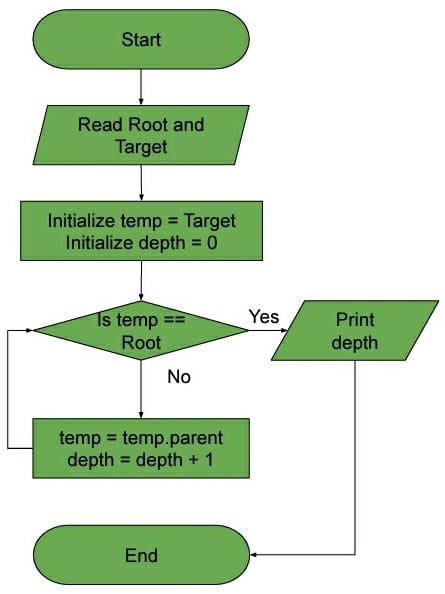1. 引言
在分析算法复杂度或设计树结构相关的逻辑时,树的深度(depth)与高度(height) 是两个非常关键的属性。虽然这两个概念经常被混淆,但它们的定义和应用场景是完全不同的。本文将从定义、计算方式和复杂度三个方面来阐述它们的区别。
2. 概念解析
✅ 树中每个节点都有两个属性:
- 深度(Depth):该节点到根节点的边数(edge)。
- 高度(Height):该节点到其最远叶子节点的边数。
⚠️ 注意:
- 根节点的深度为 0。
- 叶子节点的高度为 0。
- 整棵树的“高度”等于根节点的高度。
- 整棵树的“最大深度”等于最深叶子节点的深度。
3. 图解说明
我们来看两个图示,帮助你更直观理解这两个概念。
✅ 找高度(Find Height)

高度的计算通常采用递归方式,一个节点的高度是其所有子节点中最大高度加一。
✅ 找深度(Find Depth)

深度的计算则从目标节点向上追溯到根节点,统计经过的边数。
4. 示例代码
下面给出 Java 风格的伪代码实现,便于你理解递归与迭代的实现逻辑。
✅ 求节点高度(Height)
algorithm findHeight(Target, Root):
// INPUT
// Target = Target Node
// Root = Tree Root
// OUTPUT
// Target Node Height
height <- 0
for C in Target.children:
tempHeight <- findHeight(C, Root)
if tempHeight > height:
height <- tempHeight
height <- height + 1
return height
踩坑提醒:叶子节点没有子节点,因此其高度为 0。递归时要特别注意边界条件。
✅ 求节点深度(Depth)
algorithm findDepth(Target, Root):
// INPUT
// Target = Target Node
// Root = Tree Root
// OUTPUT
// Target Node Depth
depth <- 0
temp <- Target
while root != temp:
temp <- temp.parent
depth <- depth + 1
return depth
踩坑提醒:要确保每个节点都保存了父节点的引用,否则无法向上追溯。
5. 时间与空间复杂度对比
| 操作 | 时间复杂度 | 空间复杂度 | 说明 |
|---|---|---|---|
| 求高度(Height) | O(n) | O(n) | 通常使用 BFS 或递归实现,需遍历整个树 |
| 求深度(Depth) | O(log n) 平均情况 O(n) 最坏情况 |
O(1)(无需额外存储) | 仅需从目标节点回溯到根节点 |
⚠️ 注意:求深度的时间复杂度取决于树的高度,如果是平衡树(如 AVL、红黑树),复杂度为 O(log n),但在极端不平衡的情况下会退化为 O(n)。
6. 总结
- 深度(Depth) 是从根节点到当前节点的路径长度。
- 高度(Height) 是从当前节点到最远叶子节点的路径长度。
- 整棵树的高度 = 根节点的高度
- 整棵树的最大深度 = 最深叶子节点的深度
- 两者的计算方式不同,复杂度也有差异,理解它们有助于你更准确地分析树结构相关算法的性能。
✅ 建议:在实际开发中,尤其是在处理树形结构(如 DOM 树、文件系统目录结构、数据库索引树)时,务必区分清楚 depth 与 height,否则很容易写出“看起来对但逻辑错”的代码。